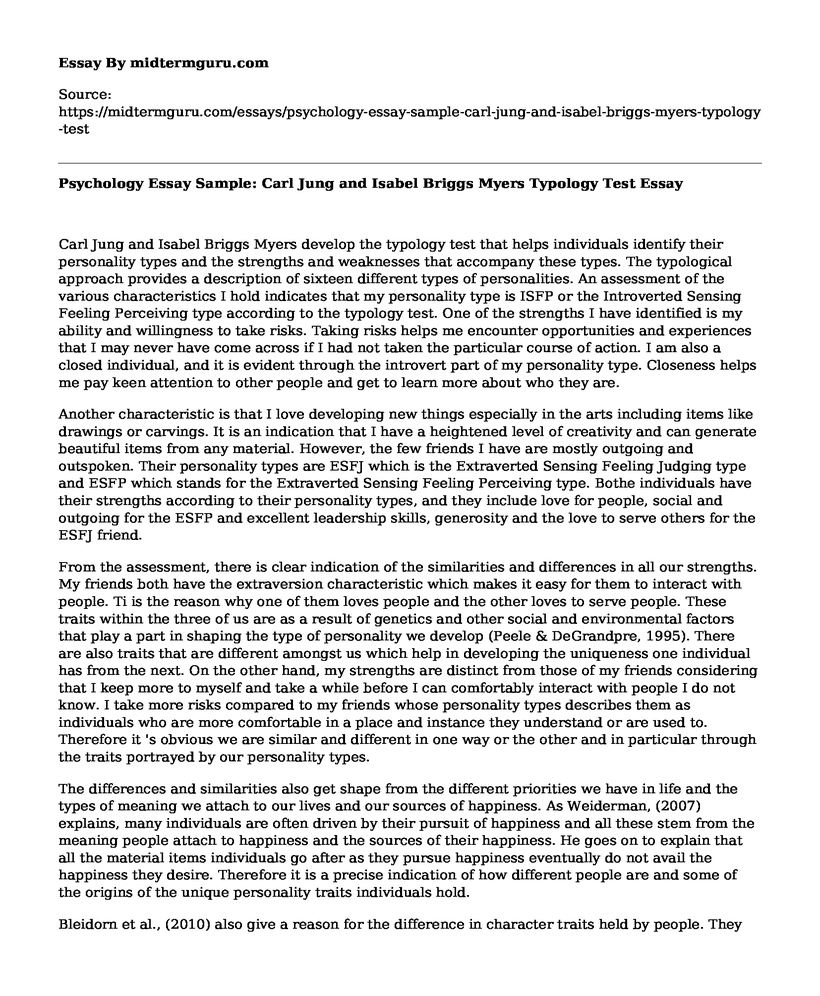Carl Jung and Isabel Briggs Myers develop the typology test that helps individuals identify their personality types and the strengths and weaknesses that accompany these types. The typological approach provides a description of sixteen different types of personalities. An assessment of the various characteristics I hold indicates that my personality type is ISFP or the Introverted Sensing Feeling Perceiving type according to the typology test. One of the strengths I have identified is my ability and willingness to take risks. Taking risks helps me encounter opportunities and experiences that I may never have come across if I had not taken the particular course of action. I am also a closed individual, and it is evident through the introvert part of my personality type. Closeness helps me pay keen attention to other people and get to learn more about who they are.
Another characteristic is that I love developing new things especially in the arts including items like drawings or carvings. It is an indication that I have a heightened level of creativity and can generate beautiful items from any material. However, the few friends I have are mostly outgoing and outspoken. Their personality types are ESFJ which is the Extraverted Sensing Feeling Judging type and ESFP which stands for the Extraverted Sensing Feeling Perceiving type. Bothe individuals have their strengths according to their personality types, and they include love for people, social and outgoing for the ESFP and excellent leadership skills, generosity and the love to serve others for the ESFJ friend.
From the assessment, there is clear indication of the similarities and differences in all our strengths. My friends both have the extraversion characteristic which makes it easy for them to interact with people. Ti is the reason why one of them loves people and the other loves to serve people. These traits within the three of us are as a result of genetics and other social and environmental factors that play a part in shaping the type of personality we develop (Peele & DeGrandpre, 1995). There are also traits that are different amongst us which help in developing the uniqueness one individual has from the next. On the other hand, my strengths are distinct from those of my friends considering that I keep more to myself and take a while before I can comfortably interact with people I do not know. I take more risks compared to my friends whose personality types describes them as individuals who are more comfortable in a place and instance they understand or are used to. Therefore it 's obvious we are similar and different in one way or the other and in particular through the traits portrayed by our personality types.
The differences and similarities also get shape from the different priorities we have in life and the types of meaning we attach to our lives and our sources of happiness. As Weiderman, (2007) explains, many individuals are often driven by their pursuit of happiness and all these stem from the meaning people attach to happiness and the sources of their happiness. He goes on to explain that all the material items individuals go after as they pursue happiness eventually do not avail the happiness they desire. Therefore it is a precise indication of how different people are and some of the origins of the unique personality traits individuals hold.
Bleidorn et al., (2010) also give a reason for the difference in character traits held by people. They bring in the factors of nature and nurture which are an indication of our genetics and the various environments we grow up. The authors explain that the personality of an individual gets its shape from his/her genetic components and also through the different environmental conditions the person gets exposure to as he/she grows up. These factors, when put together determine the type of personality one develops.
References
Bleidorn, W., Kandler, C., Hulsheger, U. R., Riemann, R., Angleitner, A., & Spinath, F. M. (2010). Nature and nurture of the interplay between personality traits and major life goals. Journal of personality and social psychology, 99(2), 366.
Peele, s. & DeGrandpre, R. (1995). My Genes Made Me Do it. Psychology Today. Retrieved 6 January 2017, from https://www.psychologytoday.com/articles/199507/my-genes-made-me-do-it
Weiderman, M. (2007). Why It's So Hard to Be Happy. Scientific American. Retrieved 7 January 2017, from https://www.scientificamerican.com/article/why-its-so-hard-to-be-hap/
Cite this page
Psychology Essay Sample: Carl Jung and Isabel Briggs Myers Typology Test. (2021, May 28). Retrieved from https://midtermguru.com/essays/psychology-essay-sample-carl-jung-and-isabel-briggs-myers-typology-test
If you are the original author of this essay and no longer wish to have it published on the midtermguru.com website, please click below to request its removal:
- Feelings of Rejection - Assignment Example
- Research Paper on Social Media Influence on Teen's Self Esteem
- The Puzzle of Personality - Essay Sample
- Paper Example on Treatment of Bipolar Disorder
- Nature and Nurture: The Uniquely Human Combination - Essay Sample
- Epidemiology of PTSD: Prevalence Across Countries - Research Paper
- Effects of Culture, Sexism and Stress on Maternal Experience - Paper Example







